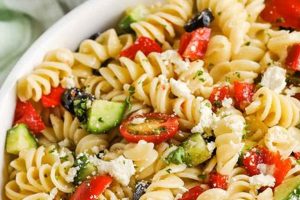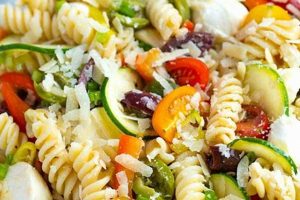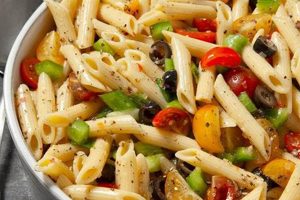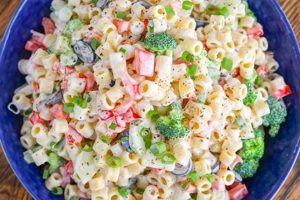A dish featuring cooked pasta, often chilled, combined with various ingredients to create a flavorful and refreshing salad. The inclusion of avocado adds a creamy texture and healthy fats, complementing the other components. An example could involve rotini pasta, cherry tomatoes, black olives, cubed avocado, and a light vinaigrette.
This combination offers nutritional value and culinary versatility. Avocado provides essential nutrients, including healthy fats, fiber, and potassium. Its creamy texture enhances the salad’s overall appeal, while its mild flavor blends well with diverse ingredients. The adaptability of this dish allows for variations based on seasonal produce and individual preferences, making it a popular choice for picnics, potlucks, and light meals. Historically, pasta salads gained popularity as refrigeration became more common, allowing for safe consumption of chilled dishes. The incorporation of avocado reflects more recent culinary trends focusing on fresh, whole ingredients.
Further exploration will cover variations on this theme, including specific recipes, ingredient selection guidance, and tips for achieving optimal flavor and texture. Nutritional information and suggested pairings will also be addressed.
Tips for Creating a Delicious Avocado Pasta Salad
Achieving optimal flavor and texture in an avocado pasta salad requires attention to several key elements. These tips offer guidance for creating a successful dish.
Tip 1: Perfectly Ripe Avocados: Select avocados that yield to gentle pressure but are not overly soft. Overripe avocados can result in a mushy texture.
Tip 2: Preventing Browning: To prevent avocado browning, incorporate it into the salad shortly before serving. A light coating of lemon or lime juice can further deter oxidation.
Tip 3: Pasta Selection: Short, sturdy pasta shapes, such as rotini, fusilli, or farfalle, hold up well in a salad and pair effectively with the creamy avocado.
Tip 4: Complementary Ingredients: Consider ingredients that complement the avocado’s flavor profile. Tomatoes, corn, black beans, red onion, and cilantro offer contrasting textures and tastes.
Tip 5: Dressing Choices: A light vinaigrette, a creamy cilantro-lime dressing, or a simple lemon-herb dressing can enhance the salad without overpowering the avocado’s subtle flavor.
Tip 6: Proper Chilling: Chill the pasta thoroughly before combining it with other ingredients. This helps maintain the salad’s freshness and prevents the pasta from becoming sticky.
Tip 7: Gentle Mixing: Toss the ingredients gently to avoid bruising the avocado and breaking the pasta.
By following these tips, one can create a flavorful and visually appealing avocado pasta salad suitable for various occasions. Proper ingredient selection, preparation techniques, and attention to timing contribute to a successful culinary experience.
The following section provides a sample recipe incorporating these recommendations and offers further insights into variations and serving suggestions.
1. Ripe Avocados
Avocado ripeness plays a crucial role in a successful pasta salad. The texture and flavor of the avocado significantly influence the overall dish. An underripe or overripe avocado can negatively impact the salad’s palatability.
- Texture:
Ripe avocados offer a smooth, creamy texture that complements the pasta and other ingredients. An underripe avocado will be firm and lack the desired creaminess, while an overripe avocado can become mushy and unappealing. The ideal texture enhances the mouthfeel of the salad.
- Flavor:
A perfectly ripe avocado possesses a rich, nutty flavor that enhances the overall taste profile of the pasta salad. Underripe avocados have a bland taste, while overripe ones can develop off-flavors. The avocado’s flavor should harmonize with the other components of the salad.
- Visual Appeal:
The vibrant green color of a ripe avocado contributes to the visual appeal of the pasta salad. Underripe avocados have a duller hue, and overripe ones can exhibit browning, detracting from the salad’s presentation. Aesthetic presentation enhances the dining experience.
- Nutritional Value:
While nutritional value remains relatively consistent throughout the ripening process, optimal ripeness ensures the best flavor and texture, encouraging consumption and maximizing enjoyment of the avocado’s health benefits. A palatable salad is more likely to be consumed, delivering the nutritional benefits of the avocado.
Selecting ripe avocados is therefore essential for achieving the desired flavor, texture, and visual appeal in a pasta salad. The ripeness directly impacts the overall culinary experience and the enjoyment of the dish. A well-balanced pasta salad incorporates a perfectly ripe avocado that complements the other ingredients and contributes to a satisfying meal.
2. Prevent browning
Maintaining the vibrant green color of avocado is crucial for the visual appeal of an avocado pasta salad. Avocado browning, a result of enzymatic oxidation upon exposure to air, can significantly detract from the dish’s presentation. Preventing this browning is essential for creating a visually appealing and appetizing salad.
- Acidulation:
Applying an acidic substance, such as lemon or lime juice, to the exposed avocado surfaces helps inhibit enzymatic activity, slowing down the browning process. The citric acid in these juices lowers the pH, creating an environment less conducive to oxidation. This method is effective for short-term preservation, suitable for preparing avocado shortly before incorporating it into the salad.
- Air Exclusion:
Minimizing the avocado’s exposure to air is another effective strategy. Covering the cut avocado with plastic wrap, ensuring direct contact between the wrap and the avocado’s surface, limits oxidation. This technique is particularly useful for storing prepared avocado for a brief period before adding it to the salad.
- Antioxidant-Rich Ingredients:
Incorporating other antioxidant-rich ingredients into the salad, such as red onion or cherry tomatoes, can further contribute to preventing browning. These ingredients contain compounds that help neutralize free radicals, further protecting the avocado from oxidation. This method provides a supplementary layer of protection within the salad itself.
- Timing of Incorporation:
Adding the avocado to the pasta salad as close to serving time as possible minimizes its exposure to air and thus reduces browning. This approach prioritizes presentation and ensures the avocado retains its fresh appearance and flavor when the salad is served. This strategy complements other preventative measures.
These methods, employed individually or in combination, contribute significantly to maintaining the avocado’s appealing color and freshness in a pasta salad. By understanding and implementing these techniques, one can ensure the salad’s visual appeal remains intact, enhancing the overall dining experience. Prevention of browning, therefore, plays a crucial role in the successful preparation and presentation of an avocado pasta salad.
3. Pasta Choice
Pasta selection significantly influences the overall success of an avocado pasta salad. The pasta’s shape, size, and texture interact with the other ingredients, particularly the avocado, affecting the final dish’s flavor, texture, and presentation. Choosing the appropriate pasta is crucial for achieving a balanced and enjoyable salad.
Certain pasta shapes are better suited for holding the creamy avocado and other ingredients. Small, tubular shapes like rotini, penne, or fusilli offer crevices that capture the dressing and avocado, ensuring each bite delivers a harmonious blend of flavors and textures. Their compact size also allows for easy handling and serving. Conversely, long, thin pasta like spaghetti or linguine tends to tangle and become unwieldy in a salad, making it difficult to incorporate the avocado evenly. Larger, flat shapes like lasagna noodles, while potentially interesting, can become cumbersome and may not hold the avocado effectively. For example, rotini pasta’s spiral shape effectively holds the avocado, creating a visually appealing and flavorful experience, whereas spaghetti’s tendency to clump makes it less suitable.
Beyond shape, the pasta’s cooking time and texture also matter. Overcooked pasta becomes mushy and loses its structural integrity, failing to provide the necessary contrast to the creamy avocado. Slightly undercooked, al dente pasta offers a pleasant firmness that complements the avocado’s texture and prevents the salad from becoming overly soft. This balance of textures is key to a successful avocado pasta salad. Properly cooked pasta absorbs the dressing without becoming soggy, further enhancing the overall flavor and experience. Understanding the interplay of these factors shape, size, and texture empowers informed pasta selection, leading to a more satisfying and enjoyable avocado pasta salad.
4. Complementary Flavors
Flavor balance is paramount in a successful avocado pasta salad. Avocado, while offering a pleasant, creamy texture and healthy fats, possesses a relatively mild flavor. Therefore, incorporating complementary flavors enhances the overall taste profile, creating a more complex and satisfying culinary experience. These complementary flavors interact with the avocado, creating a synergistic effect where the combined taste is greater than the sum of its parts. This synergy elevates the dish beyond a simple combination of ingredients.
Several ingredients offer compelling complements to avocado. Bright, acidic notes from cherry tomatoes or a citrus vinaigrette cut through the richness of the avocado. The sharpness of red onion provides a pungent counterpoint, while the herbaceousness of cilantro or dill adds a fresh, aromatic dimension. Incorporating ingredients with contrasting textures, such as crunchy bell peppers or sweet corn kernels, further enhances the sensory experience. Consider a pasta salad with avocado, cherry tomatoes, crumbled feta cheese, and a lemon-herb vinaigrette. The tomatoes provide acidity, the feta offers a salty tang, and the vinaigrette ties the flavors together, demonstrating how complementary flavors elevate a simple avocado pasta salad. Conversely, combining avocado with overly sweet or intensely flavored ingredients could overwhelm its subtle taste, hindering overall balance.
Strategic flavor pairing extends beyond individual ingredient selection. The overall composition of the saladthe interplay of flavors, textures, and even colorscontributes to the final product’s success. Balancing richness, acidity, sweetness, and spice is essential for a well-rounded flavor profile. The practical significance of understanding complementary flavors lies in the ability to create a dish that is not only nutritious but also enjoyable and memorable. A thoughtfully constructed avocado pasta salad, with its balanced flavors and textures, is more likely to be appreciated and consumed, maximizing the nutritional benefits of the avocado and other incorporated ingredients. Achieving such balance requires an understanding of how different flavors interact and how to combine them effectively.
5. Dressing Selection
Dressing selection significantly impacts the overall flavor profile and enjoyment of an avocado pasta salad. The dressing serves as a unifying element, binding the individual ingredients and creating a cohesive culinary experience. It should complement the inherent flavors of the pasta, avocado, and other components, rather than masking them. A well-chosen dressing enhances the salad’s palatability and contributes to its overall success.
Several factors influence dressing selection. The avocado’s delicate flavor necessitates a dressing that enhances, not overwhelms. A light vinaigrette, with its balanced acidity and subtle herbal notes, often pairs well, allowing the avocado’s creaminess and the other ingredients’ flavors to shine. For example, a lemon-herb vinaigrette or a light balsamic vinaigrette complements the avocado without overpowering its subtle taste. Conversely, a heavy, creamy dressing might mask the avocado’s flavor and create an overly rich dish. A creamy cilantro-lime dressing, while flavorful, should be used judiciously to avoid overpowering the other components. The choice also depends on the other ingredients in the salad. If the salad includes strong flavors like olives or feta cheese, a lighter dressing might be preferred to balance the overall taste profile. For a salad with milder vegetables, a slightly more assertive dressing can add depth and complexity.
The practical significance of proper dressing selection lies in its ability to elevate the dish from a simple combination of ingredients to a harmonious and flavorful experience. An appropriate dressing ties the flavors together, creating a cohesive and satisfying culinary experience. Furthermore, the dressing contributes to the salad’s overall texture and mouthfeel. A vinaigrette adds a light, refreshing touch, while a creamy dressing contributes richness and body. Careful consideration of these factors ensures the dressing complements both the flavors and textures of the other ingredients, including the avocado, ultimately maximizing the enjoyment and appreciation of the pasta salad. Ignoring dressing selection risks an unbalanced and less satisfying dish. A heavy dressing can make the salad soggy and overwhelm the delicate flavors, while an insufficient or poorly chosen dressing can result in a bland and unappealing experience.
6. Proper Chilling
Proper chilling is crucial for food safety and optimal sensory experience of an avocado pasta salad. Temperature management influences both the dish’s safety and its palatability. Insufficient chilling creates opportunities for bacterial growth, while excessive chilling can negatively impact texture and flavor. Understanding the nuances of proper chilling contributes significantly to a successful and safe culinary outcome.
- Food Safety:
Maintaining a safe temperature below 40F (4C) inhibits the growth of harmful bacteria that can cause foodborne illness. Pasta salads, with their combination of cooked pasta and often perishable ingredients like avocado, are particularly susceptible to bacterial growth if not chilled adequately. Rapid cooling and consistent cold storage are essential for ensuring food safety. Prompt refrigeration after preparation minimizes the time the salad spends in the temperature danger zone where bacteria thrive. This is particularly important for dishes served at picnics or outdoor events where temperature control can be challenging.
- Texture Preservation:
Proper chilling helps maintain the desired texture of the various ingredients. Avocados, in particular, benefit from controlled chilling. Overchilling can cause the avocado to become hard and lose its creamy texture. Maintaining the salad at an appropriate chilled temperature ensures the avocado remains smooth and palatable. Other ingredients, such as vegetables, also benefit from proper chilling, retaining their crispness and freshness.
- Flavor Enhancement:
Chilling allows the flavors of the various ingredients to meld and develop. This is especially important for pasta salads, where the dressing and other components infuse the pasta over time. Proper chilling enhances this flavor development while preventing spoilage. The cool temperature also heightens the refreshing quality of the salad, making it particularly appealing in warmer weather. A well-chilled salad offers a more intense and enjoyable flavor experience compared to a salad served at room temperature.
- Serving Temperature:
While thorough chilling is essential for safety and flavor development, the ideal serving temperature for a pasta salad is slightly above refrigerator temperature. Serving the salad directly from the refrigerator can dull the flavors and make the avocado and other ingredients seem less vibrant. Allowing the salad to sit at room temperature for a short period before serving enhances the flavor profile and overall enjoyment. This brief warming allows the flavors to express themselves fully.
Proper chilling, therefore, is not merely a matter of food safety but an integral aspect of optimizing the sensory qualities of an avocado pasta salad. Balancing safety with flavor and texture considerations ensures a culinary experience that is both enjoyable and safe. The temperature management techniques employed directly impact the overall success and appeal of the dish. A properly chilled avocado pasta salad embodies the principles of both culinary excellence and food safety, offering a delightful and safe dining experience.
7. Gentle Mixing
Gentle mixing plays a crucial role in maintaining the structural integrity and aesthetic appeal of an avocado pasta salad. Avocado, with its delicate texture, is prone to bruising and breaking down if handled roughly. Similarly, overmixing can damage the pasta, causing it to become mushy and less appealing. The goal is to combine the ingredients thoroughly while preserving their individual characteristics. Aggressive mixing can result in a salad with a less desirable texture and appearance. Consider the difference between gently folding avocado chunks into cooked pasta versus vigorously stirring them. The former retains the avocado’s shape and the pasta’s structure, while the latter results in a broken-down, less visually appealing mixture.
The practical significance of gentle mixing becomes evident in the final presentation and palatability of the salad. A gently mixed salad showcases the distinct ingredients, highlighting the vibrant green of the avocado, the varied colors of the vegetables, and the appealing shape of the pasta. This visual appeal enhances the dining experience. Moreover, maintaining the integrity of the ingredients contributes to a more enjoyable texture. Each bite offers distinct textural elements, from the creamy avocado to the firm pasta and crisp vegetables. This contrast of textures is lost when ingredients are overmixed and become homogenized. For instance, a gently mixed salad allows one to appreciate the smooth avocado alongside the al dente pasta, whereas an overmixed salad might present a less appealing, mushy consistency.
In summary, gentle mixing represents a critical step in crafting a successful avocado pasta salad. It preserves the structural integrity of delicate ingredients like avocado and pasta, contributing significantly to both the visual appeal and textural enjoyment of the dish. This technique, while seemingly simple, demonstrates a nuanced understanding of how handling affects the final product. Failure to employ gentle mixing can compromise the desired outcome, resulting in a less visually appealing and less palatable salad, underscoring the importance of this often overlooked step in the preparation process.
Frequently Asked Questions
This section addresses common inquiries regarding the preparation and enjoyment of avocado pasta salad.
Question 1: How can browning of avocados be minimized in a pasta salad?
Lemon or lime juice applied to exposed avocado surfaces inhibits enzymatic browning. Incorporating the avocado close to serving time and storing the salad properly also helps.
Question 2: Which pasta shapes are most suitable for avocado pasta salad?
Short, sturdy pasta shapes, such as rotini, fusilli, or penne, hold up well in the salad and effectively capture the dressing and avocado.
Question 3: What ingredients complement the flavor of avocado in a pasta salad?
Ingredients offering contrasting flavors and textures create a balanced profile. Tomatoes, red onion, corn, black beans, cilantro, and feta cheese are excellent choices.
Question 4: What type of dressing is recommended for avocado pasta salad?
Light vinaigrettes, such as lemon-herb or balsamic, complement the avocado without overpowering its subtle flavor. Creamy dressings should be used sparingly.
Question 5: How long can avocado pasta salad be safely stored?
Properly stored in an airtight container in the refrigerator, avocado pasta salad is typically safe to consume for up to three days, though quality may diminish over time.
Question 6: Can frozen avocados be used in pasta salad?
While frozen avocado can be used in some recipes, it often loses its firm texture upon thawing, making it less suitable for pasta salad where texture is key. Fresh avocado is generally recommended.
Careful attention to these considerations ensures optimal flavor, texture, and food safety. Understanding these aspects contributes to a more satisfying culinary experience.
The subsequent section will offer a selection of varied recipes showcasing the versatility of avocado pasta salad.
Avocado Pasta Salad
This exploration examined the multifaceted aspects of incorporating avocado into pasta salad. Key considerations include avocado selection and handling to prevent browning, pasta shape selection for optimal texture and ingredient compatibility, complementary flavor pairings to enhance the avocado’s subtle taste, appropriate dressing choices to create a balanced flavor profile, proper chilling techniques for food safety and flavor optimization, and gentle mixing methods to preserve ingredient integrity. Each element contributes significantly to the overall success of the dish, highlighting the importance of informed culinary practices.
Avocado pasta salad represents a versatile and nutritious culinary creation. Careful attention to ingredient selection, preparation techniques, and flavor balancing elevates this dish beyond a simple combination of components. Further culinary exploration and individual experimentation promise continued discovery of the diverse possibilities within this adaptable and enjoyable dish.






